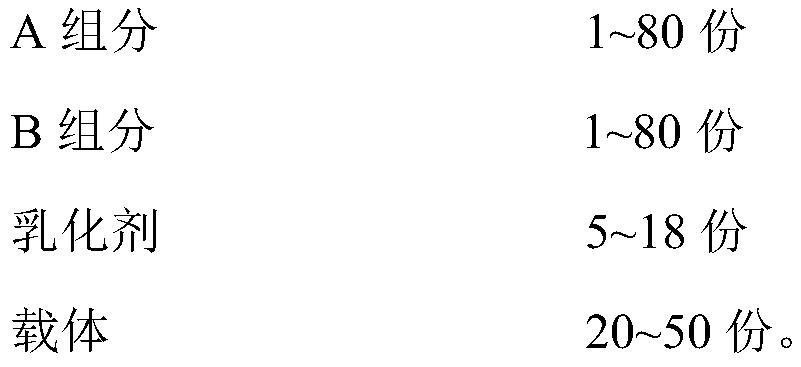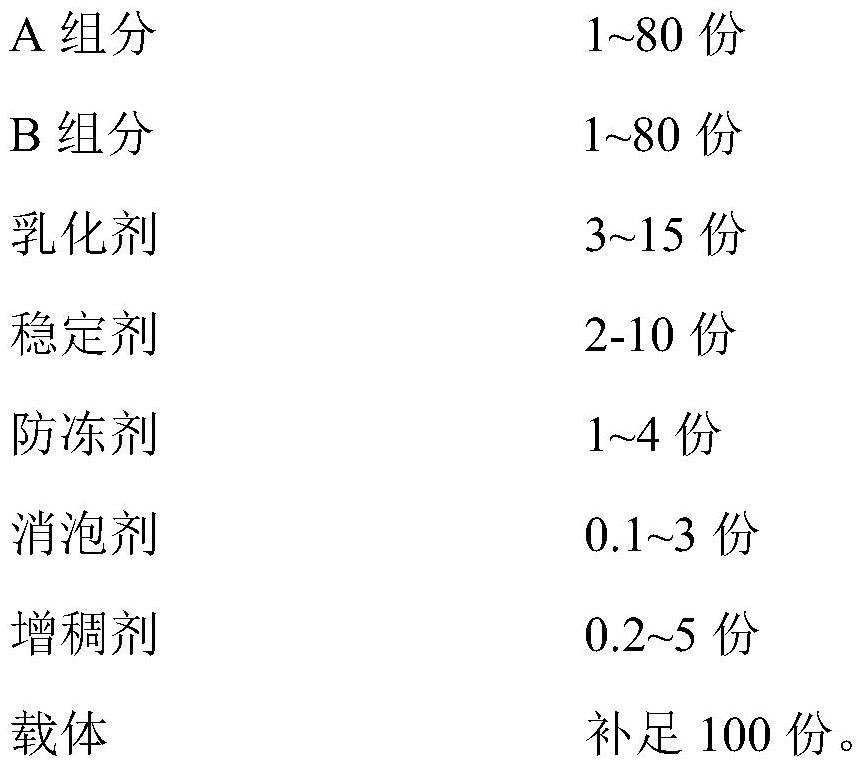Insecticidal composition and application thereof in pest control
An insecticidal composition and a technology for preventing and controlling pests, which are applied in the application, insecticide, biocide and other directions, can solve the problems of few types of pests and single application method, and achieve low residual amount, wide range of action and environmental friendliness. Effect
- Summary
- Abstract
- Description
- Claims
- Application Information
AI Technical Summary
Problems solved by technology
Method used
Image
Examples
Embodiment 1
[0058] Calculate the toxicity index and co-toxicity coefficient (CTC) of the drug by calculating the co-toxicity coefficient of the compound according to the toxicity index.
[0059]
[0060] Theoretical toxicity index (TTI) = ∑ (the toxicity index TI of each single agent × the percentage of single agent in the mixture)
[0061]
[0062] Experimental judgment basis:
[0063] When CTC≤80, the composition exhibits antagonistic effect; when 80
[0064] Mix 2-chloro-6-((4-phenoxyphenoxy)methyl)pyridine and pyrenpyramide according to the weight ratio of 80:1~1:80 to obtain various compositions, select several specific weights Than the corresponding composition to measure its toxicity to the rice leaf roller, the test results are as shown in table 1:
[0065] Table 1 Comparison of virulence test results against rice leaf roller
[0066]
[0067] Analysis of exper...
Embodiment 2
[0075] Experimental effect calculation method and experimental judgment basis: the same as in Example 1.
[0076] Mix 2-chloro-6-((4-phenoxyphenoxy)methyl)pyridine and pyrenpyramide according to the weight ratio of 80:1~1:80 to obtain various compositions, select several specific weights Than the corresponding composition to measure its toxicity to Chilo suppressalis, test result is as shown in table 2:
[0077] Table 2 Comparison of toxicity test results against Chilo suppressalis
[0078]
[0079] Analysis of experimental results: It can be seen from Table 2 that:
[0080] 1) The measured toxicity index (ATI) of 2-chloro-6-((4-phenoxyphenoxy)methyl)pyridine and tofenpyramide in the weight range of 20:1-1:80 were all higher than Toxicity Index (TTI). Especially in the weight ratio range of 2-chloro-6-((4-phenoxyphenoxy)methyl)pyridine and tofenpyramide in the range of 20:1-1:80, ATI is much higher than TTI, indicating synergistic The effect is obvious.
[0081] 2) The...
Embodiment 3
[0087] Experimental effect calculation method and experimental judgment basis: the same as in Example 1.
[0088] Mix 2-chloro-6-((4-phenoxyphenoxy)methyl)pyridine and pyrenpyramide according to the weight ratio of 80:1~1:80 to obtain various compositions, select several specific weights Than the corresponding composition to measure its toxicity to diamondback moth, test result is as shown in table 3:
[0089] Table 3 Comparison of the toxicity test results of diamondback moth
[0090]
[0091]
[0092] Analysis of experimental results: It can be seen from Table 3 that:
[0093] 1) The measured toxicity index (ATI) of 2-chloro-6-((4-phenoxyphenoxy)methyl)pyridine and tofenpyramide in the weight range of 80:1-1:80 were all higher than Toxicity Index (TTI). Especially in the weight ratio range of 2-chloro-6-((4-phenoxyphenoxy)methyl)pyridine and tofenpyramide in the range of 40:1-1:40, ATI is much higher than TTI, indicating synergistic The effect is obvious.
[0094]...
PUM
 Login to View More
Login to View More Abstract
Description
Claims
Application Information
 Login to View More
Login to View More - R&D
- Intellectual Property
- Life Sciences
- Materials
- Tech Scout
- Unparalleled Data Quality
- Higher Quality Content
- 60% Fewer Hallucinations
Browse by: Latest US Patents, China's latest patents, Technical Efficacy Thesaurus, Application Domain, Technology Topic, Popular Technical Reports.
© 2025 PatSnap. All rights reserved.Legal|Privacy policy|Modern Slavery Act Transparency Statement|Sitemap|About US| Contact US: help@patsnap.com



